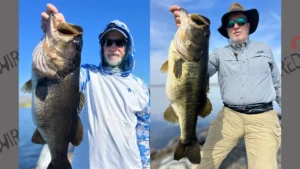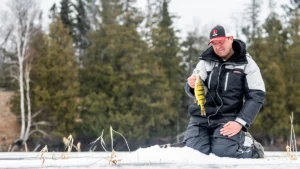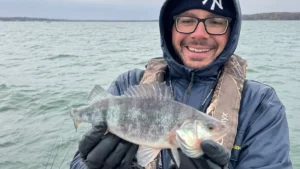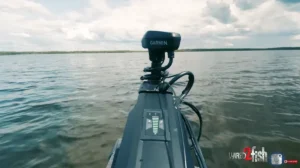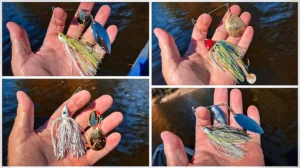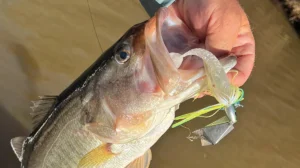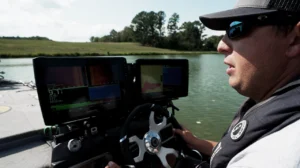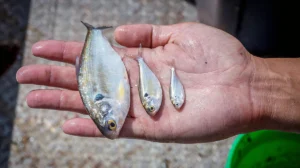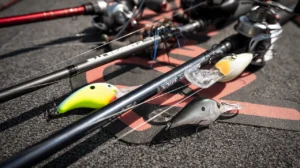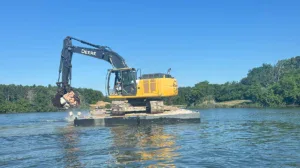Stefan Turko had watched bluefin tuna migrate along the North Carolina coast for days, carefully planning how to catch one from his 12-foot Hobie pedal-powered kayak.
“I knew a couple of bluefin had been hooked and lost by fishermen on Jennette’s Pier near Nags Head,” said the 22-year-old Turko, a charter boat mate from his hometown of Kitty Hawk. “I figured if they were hooking them from a pier, I could get one from my kayak.”
So, early on April 4, Turko slid his kayak into the Atlantic Ocean at Kitty Hawk and headed offshore. He was alone and didn’t have to go far before he saw bait showering the surface. Leaping and boiling tuna were chasing and feeding on them.
“I was about a half-mile offshore and started seeing small schools of two to 10 tuna moving north fast, chasing baitfish,” he explained. “I was in about 20 feet of water, just off Jennette’s Pier.
“The fish were not far from an anchored weather buoy, which I think attracted a lot of baitfish. I used a ‘No Live Bait Needed’ 5-inch white swim bait that looked like the bait they were chasing. I’d get close to where I saw tuna boil the surface, then cast.”

Most of the tuna and bait were located between the end of Jennette’s Pier and the weather buoy, and he was about 500 yards off the pier and inshore of the buoy.
Turko used an 8-foot Rainshadow RX6 spinning rod, paired with a Van Staal 250 heavy-duty marine spinning reel, packed with 450 yards of 65-pound-test Power Pro braided line and a 6-foot, 150-pound-test monofilament leader.
He was into fish right away that morning, with the tuna readily striking his swimbait rigged to a jighead.
“I hooked four tuna in the 100- to 200-pound class that morning,” Turko explained. “I lost the first three. One tuna I had on for about 10 minutes before the line broke when the fish was just 20 feet away. There were a lot of baitfish and bluefish around, and one of those may have nicked my line, causing the break-off on the first three tuna.
“But the fourth fish I hooked that day was the charm.”
Around mid-day, he spotted a single tuna chasing bait and moving toward him in his kayak, which rolled on slow ocean swells, with a water temperature of 52 degrees.
“That single tuna would pop up every few minutes, chasing bait toward me,” Turko said. “When it came up just 20 yards away, I cast to it, let my lure sink a bit, started jigging it, and it hit.”

Turko had brought a 5-gallon bucket with him, tied with heavy rope to the rear of his kayak. When he hooked the tuna, he put the bucket overboard, filling it with water. He says the bucket helped wear out the tuna due to its weight when the fish took off, towing the kayak in a modern-day version of a “Nantucket sleighride.”
“The water-filled bucket helped stabilize my kayak as the fish zipped away, towing me behind,” Turko said. “It also helped wear down the bluefin.”
Turko had learned from other tuna anglers that the fastest way to beat a notoriously tough-fighting bluefin is to stay right on top of it and battle it hard and fast. That’s what he did.
“I was also lucky because there was an offshore wind blowing, and the fish headed shallow into the wind and toward land,” Turko explained. “Towing me, the kayak, and the bucket wore it down pretty fast.”
He had to get the bucket out of the water while fighting the fish so it wouldn’t snag on the line. That was tough while fighting the tuna, but he managed to get the bucket aboard his kayak.
After about 30 minutes of fighting the bluefin, the fish started to “pinwheel” — swimming in tight circles below Turko’s pedal-powered kayak. Finally, the fish surfaced near Turko, belly up and whipped. The young angler gaffed the fish in the head and drew it to his kayak. Then, he whacked the fish several times in the head with an old aluminum baseball bat he’d had since playing Little League baseball.
Once the fish was dead at the side of his kayak, he secured it with a rope through its gills and clipped a large diver’s float to the fish and kayak.
Next, he called his friends to alert them to what had just happened and started pedaling back to the Kitty Hawk beach.

His buddies were there to help him land the bluefin and kayak. People on the nearby pier watched in awe, and crowds gathered on the beach to see and touch the heavy tuna.
Later that afternoon, the fish weighed 136 pounds and measured 69 inches in length.
Bluefin tuna harvest is highly regulated, but the fish was under the 73-inch recreational maximum catch length. Turko also had a federal marine fisheries permit for harvesting tuna, but since the fish was caught in North Carolina state waters, federal regulations did not apply.
He’s planning to have an ink print made of the tuna’s wide and distinctive tail and display it with a picture of himself, his bluefin, and the lure he used to catch it. He also made a bracelet from part of the heavy leader used to catch the fish.
“I said a prayer on the way out that morning for a safe day, and God blessed me more than I could have imagined,” he said.


